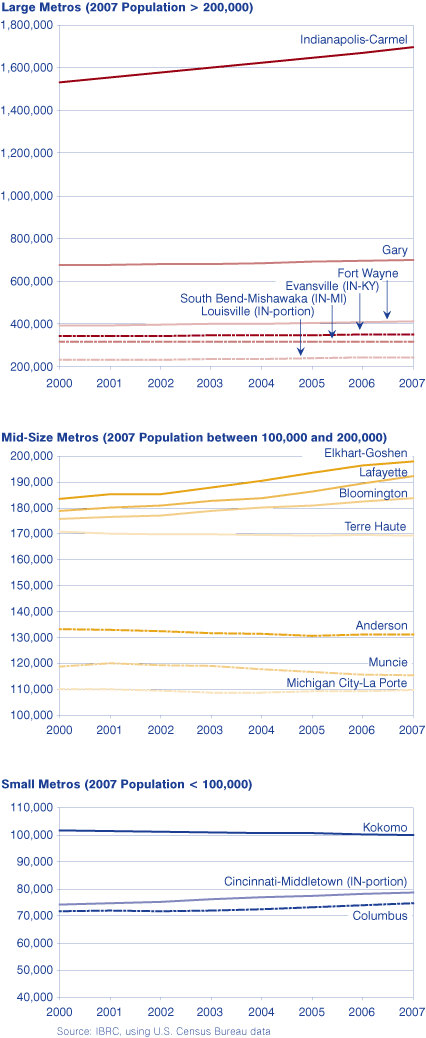Population Change Among Indiana's Metros
Three of every four Hoosiers live in a metropolitan area, and 13 of Indiana's 16 metro areas had more people in 2007 than in 2006, according to the latest Census Bureau estimates.1 Not surprisingly, the Indianapolis-Carmel metro led the state in both numeric growth (24,705) and percent growth (1.5 percent). Muncie experienced the largest one-year losses among Indiana's metros, declining by 261 people (-0.2 percent).
Of course, change over a single year must be put into context. The three graphs comprising Figure 1 show the July 1 population estimate for each year this decade. While this allows us to see, quite literally, how the metros stack up to each other in total population and population change, it is difficult to make out the trends for some individual metros. The 16 graphs that comprise Figure 2 provide this valuable information. (The astute reader will notice the scale varies on these graphics in order to hone in on regional trends and will be judicious in making comparisons between metros using these graphics.)
Figure 1: Metro Population Estimates, 2000 to 2007

Figure 2: Metro Population Trends, 2000 to 2007

What we can see is that 10 metros have grown consistently since July 2000, with the total change between 2000 and 2007 ranging from 2 percent in Evansville to nearly 11 percent in Indianapolis-Carmel. Meanwhile, three metros have consistently lost population, with Muncie declining almost 3 percent from 2000 levels, Kokomo declining roughly 2 percent and Terre Haute declining 1 percent.
Three other metros declined in the early parts of the decade, but have since rebounded. Both South Bend–Mishawaka and Michigan City–La Porte have regained nearly all of the lost ground and each are less than 400 people shy of their 2000 population levels. Meanwhile, Anderson has experienced a recent uptick in population, gaining 0.4 percent from its low of 130,750 people in 2005. Perhaps next year's data will give a better indication if a true population rebound is emerging, given that Anderson's economy is continuing its shift away from auto manufacturing employment.
Notes
- For purposes of this article, we analyze only the Indiana portion of the Louisville–Jefferson County (KY-IN) metro and the Cincinnati-Middletown (OH-KY-IN) metro since the primary cities and the bulk of those populations are in neighboring states. The Gary metropolitan division is used instead of the full Chicago-Naperville-Joliet (IL-IN-WI) metro for the same reasons. However, for the metros where the metro's principal city is within Indiana—such as the South Bend–Mishawaka (IN-MI) metro— the full metro definition is used.
Rachel Justis, Managing Editor
Indiana Business Research Center, Kelley School of Business, Indiana University
